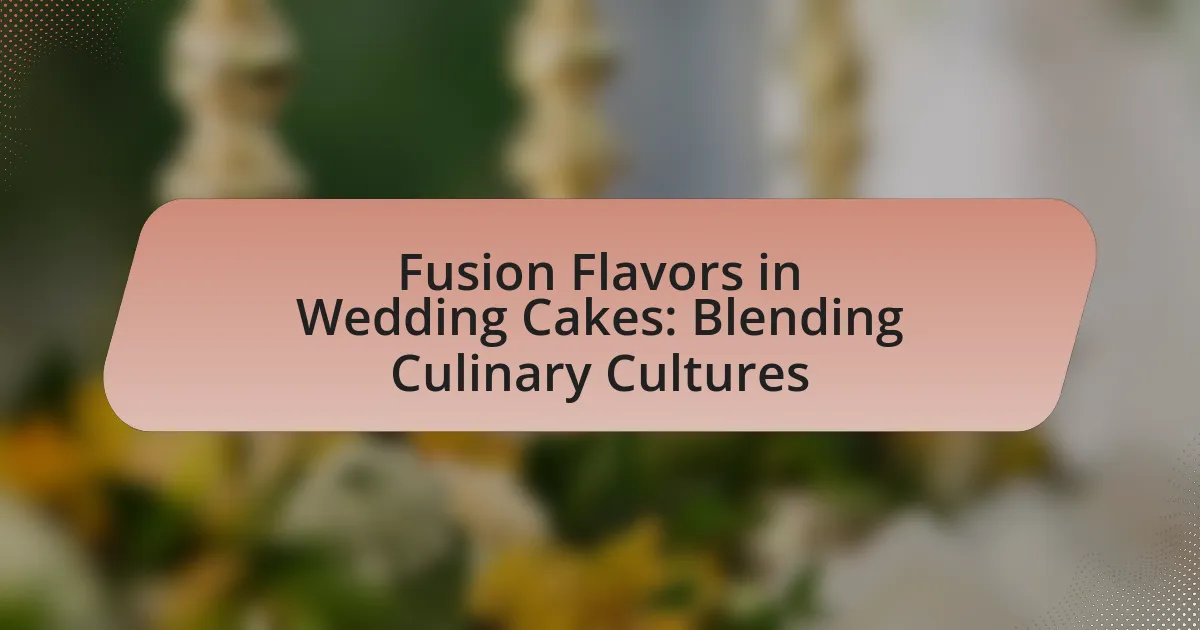Fusion flavors in wedding cakes involve the integration of diverse culinary traditions and flavor profiles to create unique cake experiences that reflect multicultural backgrounds. This trend enhances traditional wedding cakes by introducing innovative combinations, such as vanilla infused with chai spices or chocolate layered with mango mousse, catering to a wider range of palates. Cultural influences from various regions, including Asian, European, and Latin American cuisines, contribute to these flavors, allowing couples to personalize their celebrations. The article explores how fusion flavors symbolize the couple’s heritage, the growing popularity of this trend, and best practices for creating successful fusion wedding cakes, including balancing flavors and collaborating with bakers.

What are Fusion Flavors in Wedding Cakes?
Fusion flavors in wedding cakes refer to the combination of diverse culinary traditions and flavor profiles to create unique cake experiences. This approach often blends elements from different cultures, such as incorporating spices, fruits, or techniques from various cuisines. For example, a wedding cake might feature a traditional vanilla base infused with chai spices, or a chocolate cake layered with mango mousse, reflecting both Western and Asian influences. The trend of fusion flavors in wedding cakes has gained popularity as couples seek to personalize their celebrations and represent their multicultural backgrounds, enhancing the overall dining experience at weddings.
How do fusion flavors enhance traditional wedding cakes?
Fusion flavors enhance traditional wedding cakes by introducing diverse taste profiles that reflect various culinary cultures. This blending of flavors allows for unique combinations, such as incorporating spices from Indian cuisine or tropical fruits from Caribbean traditions, which can elevate the overall sensory experience of the cake. For instance, a vanilla cake infused with matcha or a chocolate cake layered with mango mousse not only adds complexity but also caters to a wider range of palates, making the cake more memorable. The incorporation of these flavors can also symbolize the union of different backgrounds, adding a personal touch to the celebration.
What cultural influences contribute to fusion flavors in wedding cakes?
Cultural influences that contribute to fusion flavors in wedding cakes include diverse culinary traditions from various regions, such as Asian, European, and Latin American cuisines. For instance, the incorporation of matcha from Japanese culture or tropical fruits like mango and coconut from Caribbean traditions can create unique flavor profiles. Additionally, the blending of techniques, such as French pastry methods with Indian spices, exemplifies how cultural exchange enhances wedding cake flavors. This fusion reflects the growing trend of multicultural weddings, where couples seek to honor their heritages through innovative culinary expressions.
How do fusion flavors reflect the couple’s heritage?
Fusion flavors reflect the couple’s heritage by combining traditional ingredients and cooking techniques from their respective cultures. For instance, a couple with Italian and Indian backgrounds might create a wedding cake that features layers of saffron-infused vanilla cake paired with mascarpone frosting, showcasing both the rich spices of Indian cuisine and the creamy textures typical of Italian desserts. This blending not only honors their individual heritages but also symbolizes their union, creating a unique culinary experience that tells their story.
Why are fusion flavors becoming popular in wedding cakes?
Fusion flavors are becoming popular in wedding cakes because they reflect diverse culinary traditions and cater to varied tastes. This trend allows couples to personalize their wedding cakes by incorporating flavors from different cultures, enhancing the overall dining experience. For instance, the combination of traditional vanilla with exotic spices like cardamom or flavors like matcha showcases a blend of cultural influences. Additionally, a survey by The Knot in 2022 indicated that 30% of couples opted for unique flavor combinations in their wedding cakes, highlighting the growing demand for innovative and personalized options.
What trends are driving the demand for fusion flavors in wedding cakes?
The demand for fusion flavors in wedding cakes is driven by the increasing desire for personalization and cultural representation in celebrations. Couples are seeking unique culinary experiences that reflect their diverse backgrounds and tastes, leading to the incorporation of flavors from various cuisines. For instance, the popularity of global travel and multicultural relationships has influenced couples to choose combinations like matcha and vanilla or mango and coconut, which blend traditional cake elements with exotic flavors. This trend is supported by data from wedding industry reports indicating that 30% of couples now opt for non-traditional cake flavors, showcasing a shift towards more innovative and personalized dessert options.
How do fusion flavors cater to diverse guest preferences?
Fusion flavors cater to diverse guest preferences by combining elements from various culinary traditions, allowing for a broader range of tastes and experiences. This approach enables chefs to create unique flavor profiles that appeal to different cultural backgrounds and dietary needs, enhancing guest satisfaction. For instance, a wedding cake that incorporates flavors like matcha from Japanese cuisine and vanilla from Western traditions can attract guests with varying palates. Additionally, research indicates that multicultural menus can increase guest engagement and enjoyment, as they reflect the diverse backgrounds of attendees, making the dining experience more inclusive and memorable.

What are the Key Elements of Fusion Flavors in Wedding Cakes?
The key elements of fusion flavors in wedding cakes include the combination of diverse cultural ingredients, innovative flavor pairings, and unique presentation styles. These elements allow bakers to blend traditional cake recipes with flavors from various culinary backgrounds, such as incorporating spices from Indian cuisine or tropical fruits from Southeast Asia. For example, a cake might feature a classic vanilla base infused with matcha green tea and layered with mango mousse, showcasing a blend of Western and Asian influences. This approach not only enhances the taste profile but also reflects the couple’s heritage and personal preferences, making the wedding cake a meaningful centerpiece.
What types of flavors are commonly fused in wedding cakes?
Commonly fused flavors in wedding cakes include vanilla and almond, chocolate and raspberry, lemon and blueberry, and red velvet with cream cheese. These combinations are popular due to their complementary tastes and textures, enhancing the overall flavor profile of the cake. For instance, vanilla and almond create a rich, aromatic base, while chocolate and raspberry offer a balance of sweetness and tartness. The fusion of these flavors reflects a trend in culinary culture that embraces diverse tastes, appealing to a wide range of palates at weddings.
How do sweet and savory elements combine in fusion wedding cakes?
Sweet and savory elements combine in fusion wedding cakes by integrating contrasting flavors to create a balanced and unique taste experience. For instance, ingredients like salted caramel, which adds a savory depth, can be paired with sweet vanilla cake layers, enhancing the overall flavor profile. This combination is supported by culinary trends that emphasize the appeal of complex flavor pairings, as seen in popular desserts that incorporate elements such as herbs, spices, or cheeses alongside traditional sweet components. The successful blending of these flavors not only reflects diverse culinary cultures but also caters to a broader range of palates, making fusion wedding cakes increasingly popular in contemporary celebrations.
What role do spices play in creating fusion flavors?
Spices are essential in creating fusion flavors as they introduce diverse taste profiles and aromatic complexities that enhance culinary experiences. By combining spices from different cultures, chefs can craft unique flavor combinations that reflect a blend of traditions, such as incorporating cardamom from Indian cuisine with cinnamon from Western baking. This fusion not only elevates the sensory appeal of dishes but also allows for innovative interpretations of classic recipes, making them more exciting and culturally rich. The use of spices in fusion cooking has been documented in various culinary studies, highlighting their ability to bridge cultural gaps and create harmonious flavor profiles.
How can different culinary techniques be integrated into wedding cakes?
Different culinary techniques can be integrated into wedding cakes by combining various baking methods, flavor profiles, and decoration styles from diverse culinary traditions. For instance, incorporating techniques such as sous-vide for infusing flavors into cake layers or using traditional Japanese matcha in a classic French buttercream can create unique taste experiences. Additionally, employing techniques like layering different textures, such as a spongy chiffon cake with a dense ganache, enhances the overall mouthfeel. The use of global ingredients, such as spices from Indian cuisine or fruits from tropical regions, can further elevate the flavor profile. This approach not only reflects a blend of cultures but also caters to a wider range of palates, making the wedding cake a centerpiece of culinary artistry.
What baking methods enhance the fusion flavor experience?
Baking methods that enhance the fusion flavor experience include techniques such as layering, infusing, and using alternative baking styles like steam baking. Layering allows for the combination of diverse flavors and textures, creating a more complex taste profile. Infusing ingredients, such as spices or extracts from different culinary traditions, directly into batters or frostings can elevate the overall flavor experience. Steam baking, often used in Asian desserts, can add moisture and a unique texture that complements various flavor combinations. These methods not only enhance the taste but also reflect the blending of culinary cultures, making them ideal for fusion wedding cakes.
How do presentation styles reflect fusion culinary cultures?
Presentation styles reflect fusion culinary cultures by showcasing the integration of diverse culinary traditions through visual aesthetics and plating techniques. For instance, a wedding cake that combines elements from both Japanese and French pastry traditions may feature delicate matcha-flavored layers adorned with intricate fondant designs, illustrating a blend of flavors and cultural artistry. This visual representation not only highlights the unique characteristics of each culture but also signifies the harmonious coexistence of different culinary practices, as seen in the increasing popularity of fusion cuisine in contemporary culinary arts.

How to Successfully Create Fusion Flavors in Wedding Cakes?
To successfully create fusion flavors in wedding cakes, begin by selecting complementary flavor profiles from different culinary traditions. For instance, combining traditional vanilla cake with matcha or incorporating spices like cardamom into chocolate ganache can create unique taste experiences. Research indicates that flavor pairing based on shared aromatic compounds enhances the overall taste, making the fusion more harmonious. Additionally, using ingredients like tropical fruits in classic recipes can introduce freshness and surprise, appealing to diverse palates. This approach not only respects the original flavors but also innovatively blends them, resulting in a memorable wedding cake that reflects the couple’s cultural backgrounds and preferences.
What are the best practices for developing fusion flavor combinations?
The best practices for developing fusion flavor combinations include understanding the flavor profiles of different cuisines, balancing contrasting tastes, and experimenting with ingredient pairings. Understanding flavor profiles allows chefs to identify complementary and contrasting elements, such as sweet and savory or spicy and mild, which can enhance the overall dish. Balancing contrasting tastes ensures that no single flavor overwhelms the others, creating a harmonious blend. Experimenting with ingredient pairings, such as combining traditional spices from one culture with base ingredients from another, can lead to innovative and unique flavor experiences. These practices are supported by culinary studies that emphasize the importance of flavor balance and cultural understanding in successful fusion cuisine.
How can couples collaborate with bakers to create unique flavors?
Couples can collaborate with bakers to create unique flavors by sharing their personal tastes and cultural backgrounds, which allows bakers to design customized cake recipes that reflect the couple’s preferences. For instance, couples can suggest specific ingredients or flavor profiles from their heritage, such as incorporating spices from Indian cuisine or tropical fruits from Caribbean traditions. This collaboration not only results in a cake that is tailored to the couple’s unique story but also enhances the overall wedding experience by celebrating diverse culinary traditions. By actively participating in the flavor development process, couples ensure that their wedding cake is a true representation of their identity and shared journey.
What should be considered when balancing flavors in a fusion cake?
When balancing flavors in a fusion cake, it is essential to consider the harmony between contrasting and complementary flavors. The integration of diverse culinary traditions requires an understanding of how different ingredients interact; for example, pairing sweet elements with acidic or bitter notes can create a well-rounded taste profile. Additionally, the texture and moisture content of each component must be evaluated to ensure a cohesive mouthfeel. Research indicates that successful flavor balance often relies on the principle of umami, which enhances overall flavor perception, making it crucial to incorporate ingredients that provide depth, such as nuts or aged cheeses.
What tips can ensure a successful fusion wedding cake?
To ensure a successful fusion wedding cake, it is essential to harmoniously blend flavors and textures from different culinary traditions. Start by selecting complementary flavors that enhance each other, such as pairing traditional vanilla with exotic spices like cardamom or saffron. Additionally, consider the cake’s structure; for instance, a dense cake can support rich fillings like mango mousse or chocolate ganache, which are popular in various cultures.
Incorporating visual elements from both cultures, such as decorative motifs or color schemes, can also enhance the cake’s appeal. For example, using edible flowers or intricate piping techniques can reflect cultural artistry. Finally, conducting taste tests with a diverse group of people can provide valuable feedback, ensuring that the final product resonates with guests from different backgrounds. This approach is supported by culinary experts who emphasize the importance of balance and creativity in fusion cuisine.
How can taste testing help refine fusion flavor choices?
Taste testing can significantly refine fusion flavor choices by providing direct feedback on the palatability and balance of combined ingredients. This process allows chefs to assess how different cultural flavors interact, ensuring that the final product appeals to diverse tastes. For instance, a study published in the Journal of Culinary Science & Technology highlights that sensory evaluation through taste testing can identify which flavor combinations are harmonious and which may clash, leading to more successful fusion dishes. By systematically gathering data on preferences during taste tests, culinary professionals can make informed adjustments to recipes, enhancing the overall flavor profile of fusion wedding cakes.
What are common pitfalls to avoid when creating fusion wedding cakes?
Common pitfalls to avoid when creating fusion wedding cakes include neglecting flavor balance, overlooking cultural significance, and failing to consider texture compatibility. Neglecting flavor balance can lead to overwhelming or unpalatable combinations; for instance, pairing overly sweet elements with savory components without moderation can detract from the overall experience. Overlooking cultural significance may result in disrespecting traditional elements, such as using ingredients that are not culturally appropriate or misrepresenting a cuisine. Failing to consider texture compatibility can lead to a cake that is visually appealing but unpleasant to eat, as certain textures may not complement each other well, such as a dense cake paired with a light, airy frosting.
